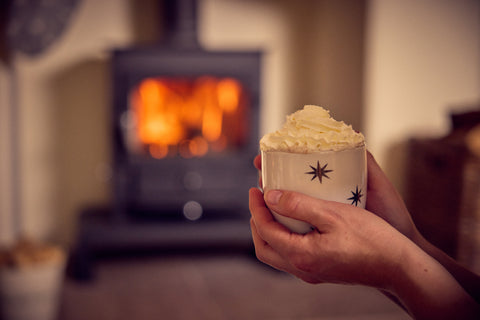
Wood stove versus central heating
Share
It would be fair to say that in terms of heating your home, using a log burner for your only source of heat is perhaps not the cheapest, assuming you are heating the whole house of course. Some however, would say it definitely saves them money, but probably because they heat less rooms and do not have all the radiators on.
Journalists have always wanted to compare heating costs on a like for like basis and always like to refer to cost per kWh, (kilowatt hour) but it has always been a difficult and perhaps unfair way to compare because using a wood burning stove is rarely for whole house heating, but selected rooms, but nevertheless, provides sufficient heat to keep you warm. Over the years, when compared with absolute pence per kWh, wood has always been more expensive when compared with oil, gas or electricity.
However, I would argue that there is a lot more to wood burning than just the cost. It is the back to our roots with a traditional form of heating using a truly renewable form of room heating and what better way is there to reduce our reliance on fossil fuels. There is really nothing to compare to the romance of a roaring log fire – just so warming, comforting and homely. Whether in your home, or sitting outside round the firepit, campfire or chimenea, nothing beats it.

Move on to January 2022 and all things change. With the Russian invasion of Ukraine there is now a massive energy crisis across Europe and not only have oil and gas prices risen dramatically, but so too has electricity with domestic electricity rising from around 15p to over 60p per kWh. As a consequence, kiln dried logs are now the cheapest form of domestic heating fuel with household costs 74% lower per kWh than electricity and 21% less than gas heating. Modern wood burning stoves also cost 29% less to run than an air source heat pump. These findings are as a result of recent research carried out by the Nottingham Energy Partnership.
In addition to these significant savings, wood fuel has the lowest carbon footprint of any domestic heating fuel. Wood logs are 87% less carbon intensive than gas, 88% less than electricity and 74% less than an air source heat pump – NB This assumes that the logs are ‘Ready to Burn’ approved (i.e. below 20% moisture content and being burnt in a modern Ecodesign stove.

According to the Stove Industry Alliance (SIA), a recent survey to retailers and installers of wood burning stoves, showed that of the stoves installed over the last 12 months, about 82% were replacements rather than new installations. This is based on a new Ecodesign stove replacing either an open fire or an older stove of over 10 years old. A modern Ecodesign compliant stove emits 90% less particulates than an open fire and up to 80% less than a much older, very basic stove model. This will mean that the replacements will help to dramatically reduce emissions from domestic indoor wood burning.
Andy Hill, chair of the SIA also highlighted the additional benefit of modern wood burning stoves in that they provide total independence from the energy grid when it comes to domestic heating. He went on to add:
“In last week’s Autumn Statement, the Chancellor of Exchequer, Jeremy Hunt, set out clear commitments to improve energy independence and reduce energy consumption. Burning good quality wood for heat in a modern Ecodesign stove offers a wealth of benefits that will not only help households manage the cost-of-living squeeze and mitigate the risks posed by winter power cuts, but they will also help the UK meet its ambitious targets on carbon reduction and energy consumption.”

When considering the pros and cons of wood burning stoves versus other forms of home heating it is perhaps just worth noting some the main tips for wood burning:
- Choose an Ecodesign compliant stove such as clearSkies certified appliance. Consider upgrading your stove if you presently use an open fire or older appliance over ten years old. You local SIA retail Group member can help advise on the best stove to suit your needs
- If you live in a Smoke Control Area, your stove will need to be Defra exempt as are all clearSkies stoves that are certified to Level 3 and above.
- Visit your local stove retailer for the best advice on choosing the right stove for your home and for a detailed quote for purchase and installation. You can find your nearest SIA Retail Group member showroom here
- Ensure your stove is maintained and fitted by a person who is approved under the qualified competent person scheme such as those registered by HETAS or OFTEC.
- You must only burn wood that is dried to below 20% moisture content so if you are buying firewood, ensure it is approved under the new Woodsure ‘Ready to Burn’ scheme. This will ensure they are below 20% moisture content. Never use chemically treated wood or burn any waste on your stove or open fire.
- Make sure your chimney is swept at least once every year by an approved sweep. Look at The Federation of British Chimney Sweeps to find a sweep near you. Sweeps can also be an excellent source of information for good practice and advise.
- Keep your stove in good condition and regularly serviced.
- Snell Nov 2022

1 comment
Dear Nic and team,
I have found your blog on Wood stoves V central heating very interesting and agree with almost all of your points.
The picture at the top shows a Clearview vision 500. I have the same which I believe is 8kw rated. We live in a single story house built in the 30’s. Double glazed throughout but with single skin brick walls so not very energy efficient. You can imagine that although the stove is almost centrally located it just cannot heat the rest of the house. However we do have a wood burning range by Marshall Sandyford with a glass door which runs the Central heating and hot water and cooking. The downside is that it’s necessary to use hard wood briquettes in order to achieve a long and consistent burn without such frequent refuelling as with logs.
Have you considered also producing briquettes? These I would definitely source from you.
As for recommending upgrading to a newer stove I think mine (although just over ten years old) is still quite efficient therefore not necessary to change.
I would think that in the present cost of living situation very few owners would consider to upgrade just now.
Many thanks for your article and keep them coming!
Kind regards,
S Beele